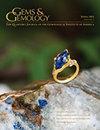Geographic Origin Determination of Paraiba Tourmaline
IF 1.6
3区 地球科学
Q2 MINERALOGY
引用次数: 3
Abstract
GEMS & GEMOLOGY WINTER 2019 Copper-bearing gem tourmaline—recognizable by its vivid neon blue to green color—has been one of the most popular colored gemstones on the market for the nearly three decades since its debut (figures 1 and 2). It was first discovered in the state of Paraíba in northeastern Brazil in the late 1980s, and subsequently found in the neighboring state of Rio Grande do Norte (Fritsch et al., 1990; Shigley et al., 2001; Furuya, 2007). These gems became known as Paraíba tourmalines after the locality of their discovery. In the early twenty-first century, similarly colored gem-quality tourmalines were discovered in Nigeria and Mozambique (figures 3 and 4; Smith et al., 2001; Abduriyim and Kitawaki, 2005). In the gem market, Brazilian Paraíba tourmalines are typically more highly valued than their African counterparts. While top-quality Brazilian Paraíba tourmalines tend to have more intense color, there is significant overlap in the color range for all localities. Additionally, standard gemological tests cannot definitively separate stones from these three localities. As a result, there is market demand for gemological laboratories to offer origin determination for copper-bearing tourmalines. The most recent Laboratory Manual Harmonisation Committee (LMHC) definition of “Paraíba” tourmaline is “a blue (electric blue, neon blue, violet blue), bluish green to greenish blue, green (or yellowish green) tourmaline, of medium-light to high saturation and tone (relative to this variety of tour-Paraiba碧玺的地理来源测定
GEMS&GEMOLOGY 2019冬季含铜宝石电气石以其生动的霓虹蓝到绿色而闻名,自问世以来近三十年来一直是市场上最受欢迎的彩色宝石之一(图1和图2)。20世纪80年代末,它首次在巴西东北部的帕拉伊巴州被发现,随后在邻近的北里奥格兰德州被发现(Fritsch等人,1990年;Shigley等人,2001年;Furuya,2007年)。这些宝石在当地被发现后被称为帕拉伊巴电气石。21世纪初,在尼日利亚和莫桑比克发现了类似颜色的宝石级电气石(图3和图4;Smith等人,2001年;Abduriyim和Kitawaki,2005年)。在宝石市场上,巴西帕拉伊巴电气石通常比非洲同行更受重视。虽然高品质的巴西帕拉伊巴电气石往往具有更强烈的颜色,但所有地方的颜色范围都有显著的重叠。此外,标准的宝石学测试并不能明确区分这三个地方的石头。因此,市场需求宝石学实验室提供含铜电气石的原产地测定。实验室手册协调委员会(LMHC)对“Paraíba”电气石的最新定义是“蓝色(电蓝色、霓虹蓝色、紫蓝色)、蓝绿色至绿蓝色、绿色(或黄绿色)电气石,中等光至高饱和度和色调(相对于这种旅游-
本文章由计算机程序翻译,如有差异,请以英文原文为准。
求助全文
约1分钟内获得全文
求助全文
来源期刊

Gems & Gemology
地学-矿物学
CiteScore
2.90
自引率
19.20%
发文量
10
期刊介绍:
G&G publishes original articles on gem materials and research in gemology and related fields. Manuscript topics include, but are not limited to:
Laboratory or field research;
Comprehensive reviews of important topics in the field;
Synthetics, imitations, and treatments;
Trade issues;
Recent discoveries or developments in gemology and related fields (e.g., new instruments or identification techniques, gem minerals for the collector, and lapidary techniques);
Descriptions of notable gem materials and localities;
Jewelry manufacturing arts, historical jewelry, and museum exhibits.
 求助内容:
求助内容: 应助结果提醒方式:
应助结果提醒方式:


